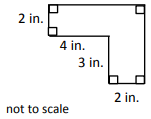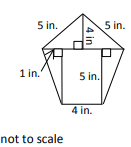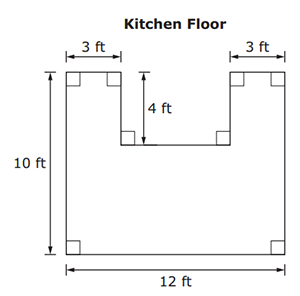Clusters should not be sorted from Major to Supporting and then taught in that order. To do so would strip the coherence of the mathematical ideas and miss the opportunity to enhance the major work of the grade with the supporting clusters.
- Assessment Limits :
Numbers in items must be nonnegative rational numbers. Limit shapes to those that can be decomposed or composed into rectangles and/or right triangles. - Calculator :
No
- Context :
Allowable
- Test Item #: Sample Item 1
- Question:
A shape is shown.

What is the area, in square inches, of the shape?
- Difficulty: N/A
- Type: EE: Equation Editor
- Test Item #: Sample Item 2
- Question:
A pentagon is shown.

What is the area, in square inches, of the pentagon?
- Difficulty: N/A
- Type: EE: Equation Editor
- Test Item #: Sample Item 3
- Question:
Mr. Hilton is buying new tile for his kitchen floor. The dimensions, in feet (ft), of the kitchen floor are shown.

What is the area, in square feet, of Mr. Hilton's kitchen floor?
- Difficulty: N/A
- Type: EE: Equation Editor
Related Courses
Related Access Points
Related Resources
Formative Assessments
Lesson Plans
Original Student Tutorials
Problem-Solving Tasks
Student Center Activity
Tutorials
Virtual Manipulatives
STEM Lessons - Model Eliciting Activity
This MEA will have students determining the safest and most cost effective material to use when building a tree house.They will do this by calculating surface area and determining cost.
Model Eliciting Activities, MEAs, are open-ended, interdisciplinary problem-solving activities that are meant to reveal students’ thinking about the concepts embedded in realistic situations. Click here to learn more about MEAs and how they can transform your classroom.
This lesson requires students to use mathematical data and logic/reasoning to place vendors into retail spaces in a shopping plaza. Students will first rank five vendor types on their profitability (based on average sales and average overhead/upkeep costs), then place the vendor types into the 11-13 retail spaces. They are also required to find the area of each space and calculate the total leasing charges. The plans for the plaza are given on a coordinate plane, so students will need to find the lengths of horizontal and vertical line segments (using the coordinates of the endpoints) to calculate the areas of the rectangular and composite spaces.
Model Eliciting Activities, MEAs, are open-ended, interdisciplinary problem-solving activities that are meant to reveal students’ thinking about the concepts embedded in realistic situations. Click here to learn more about MEAs and how they can transform your classroom.
MFAS Formative Assessments
Students are asked to find the area of a kite by composing it into rectangles or decomposing it into triangles.
Students are asked to find the area of a trapezoid and a parallelogram by composing or decomposing into triangles and rectangles.
Students are asked to solve a problem involving finding the area of a composite plane figure.
Original Student Tutorials Mathematics - Grades 6-8
Follow George as he explores the formula for the area of a triangle and uses it to find the area of various triangles in this interactive student tutorial.
Student Resources
Original Student Tutorials
Follow George as he explores the formula for the area of a triangle and uses it to find the area of various triangles in this interactive student tutorial.
Type: Original Student Tutorial
Type: Original Student Tutorial
Problem-Solving Tasks
Students are asked to determine and illustrate all possible descriptions for the base and height of a given triangle.
Type: Problem-Solving Task
Students are asked to demonstrate two different strategies for finding the area of polygons shown on grids.
Type: Problem-Solving Task
Students are asked to use the given information to determine the cost of painting a barn.
Type: Problem-Solving Task
Student Center Activity
Students can practice answering mathematics questions on a variety of topics. With an account, students can save their work and send it to their teacher when complete.
Type: Student Center Activity
Tutorials
This tutorial demonstrates how the area of an irregular geometric shape may be determined by decomposition to smaller familiar shapes.
Type: Tutorial
This video portrays a proof of the formula for area of a parallelogram.
Type: Tutorial
A trapezoid is a type of quadrilateral with one set of parallel sides. Here we explain how to find its area.
Type: Tutorial
We will be able to find the area of a triangle in a coordinate grid. The formula for the area of a triangle is given in this tutorial.
Type: Tutorial
Students will learn the basics of finding the perimeter and area of squares and rectangles.
Type: Tutorial
Parent Resources
Problem-Solving Tasks
Students are asked to determine and illustrate all possible descriptions for the base and height of a given triangle.
Type: Problem-Solving Task
Students are asked to demonstrate two different strategies for finding the area of polygons shown on grids.
Type: Problem-Solving Task
Students are asked to use the given information to determine the cost of painting a barn.
Type: Problem-Solving Task









